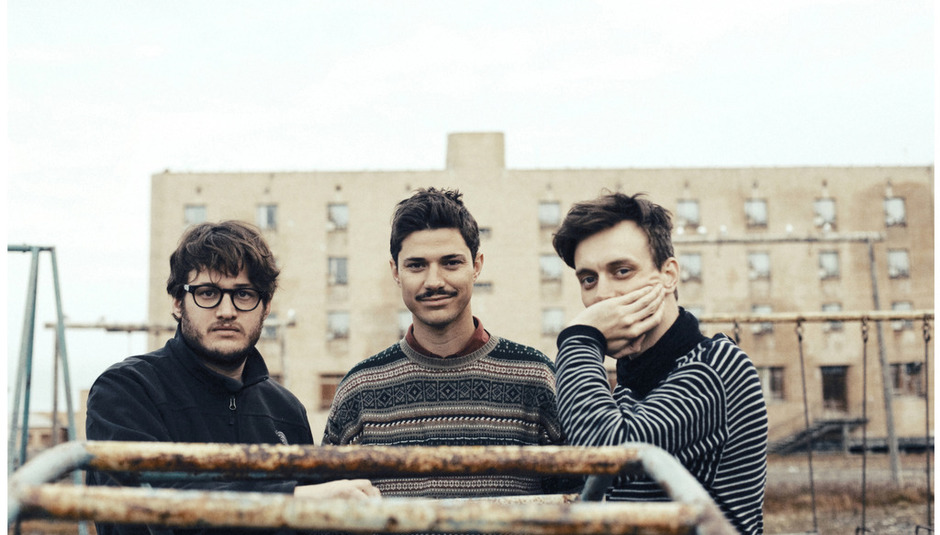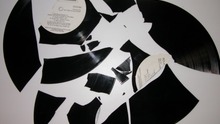In the first part of their existence Efterklang were a band who seemed to inhabit a world entirely of their own. 2007’s Parades was no doubt a landmark for the Danish band, receiving a 10/10 review on these pages and similar critical and public acclaim elsewhere. It was a masterpiece of layers with numerous live and electronic sounds in both the foreground and the periphery. Yet Parades was also somehow refined. It was then transformed into a living, breathing, all-encompassing live show with the help of various orchestras across the world; a project which included a live performance with the Britten Sinfonia at The Barbican in 2009, as well as a live album and DVD release that same year. It may have seemed at the time that their particular mountain was scaled but from that point the band have since climbed many further and more varied peaks.
In some ways, 2010’s Magic Chairs – the band’s 4AD debut – felt like a departure from what you could expect from an Efterklang album. The sense of adventure that marks the band out was present but it manifested itself in a more immediate way. A selection of orchestral-pop based tracks replaced some of their more recognisable denser, winding, technical pieces and it felt like a corner was turned. Melodies were brought to the front with the lyrics taking their place in the foreground, having previously been shrouded in a myriad of sounds. Upon completion of that record it was a departure of another sort that the Danish trio of Rasmus Stolberg, Casper Clausen and Mads Brauer had in mind for their next full-length. The idea of connecting the album to a location – something the band had previously done in working with Vincent Moon on An Island – was discussed. “We had different ideas of how we could do that”, says bassist Stolberg.
How they then decided, back in 2010, to travel to the abandoned Arctic mining town of Pyramiden on Spitsbergen is not an especially long story, even though the happenings on location and afterwards are long enough for many, many thousands of words.
“This Swedish film director e-mailed saying, ‘I’d love to do a music video with you guys…check out the photos of this place up here in the arctic, I was thinking we could go up there’. Then we looked and the photos and was like ‘Wow! This is way too good for a music video’. So we just connected with it.”
On seeing the photos of the town and researching the location and its unique recent and distant history, their minds were made up swiftly. “We went online to start to dig out material and read about this place, and then we found out the world’s northernmost grand piano stands in this town. Then it became this thing we just had to do. We got this idea to go there then we couldn’t leave the idea again.” Looking at those photos and discovering its back story – bought by the Soviet Union from Sweden in 1927 and abandoned as a working location by its Russian state-owned company in 1998 – it is not difficult to realise its fundamental irresistibility, nor to imagine the minds of the band when faced with the prospect. Though human life departed in the late ‘90s, the town’s buildings remain intact. An effort has been made by its owners Arktikugol to preserve, maintain and repair Pyramiden somewhat, yet it is still a non-functioning ghost town unable to sustain human life and is likely to remain that way.
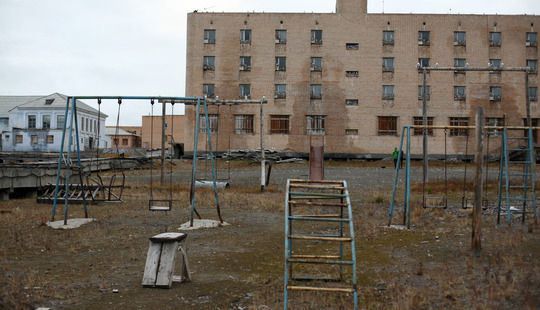 "An abandoned playground in front of what was called Mad House as this is were families with kids lived. Today the Mad House is overtaken by kittywake birds."
"An abandoned playground in front of what was called Mad House as this is were families with kids lived. Today the Mad House is overtaken by kittywake birds."
Getting there was the first challenge. Not just planning a route to a remote and relatively inaccessible island but having permission to be there and to do the things they wanted. The company that still owns the settlement turned out to be aptly inaccessible themselves. “We just couldn’t get permission and couldn’t get in contact with anyone but we realised that we had to do this. We started to plan where we could go and do something similar and we couldn’t come up with it. It was so focused that it had to be that place,” explains Stolberg.
A year later, and as hope was fading, the trio received an e-mail from a German director making a documentary series called Moderne Ruinen (Modern Ruins) who had met the company in Moscow. The all clear is given to travel with the film crew and with a similar level of access. So that was that: sorted, to a degree. Job done, it was happening. But how could three musicians possibly prepare for a trip like this? “To tell you the truth, in Efterklang we don’t know anything about survival and we ended up with these guys, so it meant that we had some guidance in terms of what to pack, what to bring and how to do it.”
That was the practical side. But mentally and creatively? They researched, naturally, and read Persistent Memories by Hein B. Bjerck, Bjørnar Olsen, Elin Andreeasen, who visited the settlement in 2006 and then published their thoughts, findings and photos of the expedition.
“It’s a really interesting book in dealing with different interests and they went there to visit it in 2005 or 2006. So we were reading a lot about it – we knew a lot about what buildings were up there. We knew there was a hospital, we knew there was a swimming pool, we knew there was a power plant, we knew that they had this piano in the concert hall.”
Despite the knowledge and ideas they’d gained through their research, the band wanted to start with a blank slate, with nothing composed or conceived before their arrival. “We had seen photos of it so we had ideas of how it would be and we pictured what kind of sounds we could get from certain places. The overall idea we had before going there was to start totally from scratch. The idea was that when the three of us arrive in Pyramiden then that would be day one for all of us,” says Stolberg.
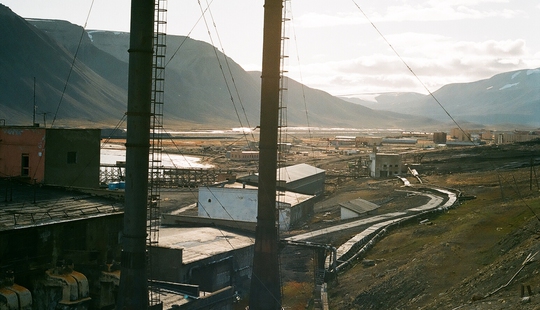
The fact that it took them so long to actually get there, combined with the fact that it looked like it would never even happen, clearly heightened emotions for Stolberg on arriving. “We had worked for so long and had this idea to go there for so long. I think I was maybe overly excited. When we finally got there, there were a few moments of thinking ‘what the hell are we doing?! Why the fuck are we in the arctic? What’s this stupid idea?’...so you lose perspective.”
After travelling so far, going through the rigmarole of getting to Pyramiden, learning about its history, myths and general presence as a shell of civilisation, there was of course the risk that perspective would indeed be lost, especially with Mads falling ill for the first two days after a particularly vigorous three-hour boat ride to the island. Oh, and the fact that that aforementioned world’s most northern grand piano “just sounds like an out of tune piano”. “That experience was quite quickly over,” says Stolberg. But like the near-overnight desertion of Pyramiden, things quickly changed. “Then we started discovering things, these instruments and sounds we could never have thought of.” Those sounds include en empty oil tank the band christened ‘Miss Piggy’ - as heard at the very beginning of opener ‘Hollow Mountain’ – and glass lamps in the mellowing ‘Told To Be Fine’.
“Suddenly, the whole vibe of the trip changed. When you make these discoveries we instantly started thinking about the music, how this sound or how these instruments could be turned into a proper instrument and how it could be turned into a song. We just got the inspiration and the joy from the whole trip.”
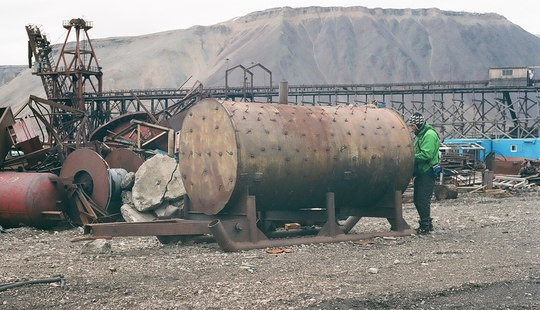 "This beast we named Miss Piggy. One of our favorite discoveries. All those small metal spikes had an individual pitch and sounded amazing. We have used this sound several times on the album. Most prominently on 'Hollow Mountain'. The opening riff of the song is played live on the spot and set the tempo and direction for the entire song."
"This beast we named Miss Piggy. One of our favorite discoveries. All those small metal spikes had an individual pitch and sounded amazing. We have used this sound several times on the album. Most prominently on 'Hollow Mountain'. The opening riff of the song is played live on the spot and set the tempo and direction for the entire song."
Being in such an alien and overwhelming location must have had its downsides but was there anything in particular that would lead the mind to wander? “One of the distractions was polar bears, that’s for sure! You’re not supposed to go out of the main settlement to Longyearbyen without a rifle or without a guard who carries a rifle. We thought we’d be under the same kind of protection as the TV team, but we didn't have any form of proper protection.” Their concern was not misplaced given that on a few weeks earlier on Spitsbergen a British student had been killed by one. “When you spend some days in the same environment…the first day you don’t see a polar bear and you’re still scared, the second day you’re still super scared, the third day you start to relax a bit more and the fourth day you’re like ‘oh, they are no Polar bears here!’ and suddenly we weren’t careful at all anymore which is really stupid.”
The band, fortunately enough, managed to avert a tragic mauling and returned from Pyramiden with over 1000 sounds and recordings collected from their nine days. Though this is a wealth of material from which to start forming a new album, it is also clearly an overwhelming volume, especially for a band as organised as Efterklang. Stolberg admits as much: “We collected way too much material. We thought we’d go through it methodically and listen to everything to see if there’s anything gold hidden somewhere but we couldn’t do that because we collected too much.”
The recordings that were earmarked as notable were picked out, modified and adapted in a consultative process, eventually being reduced to a collection of 40-odd samples. For some tracks Mads would lead the way in developing the mini-sketches before lyricist Casper Clausen would maybe add words or a piano line whereas others would be part-formed before incorporating the sounds into the piece. Finishing the record was also a job. Soon after arriving back and starting the work they were asked to play the Sydney Opera House something which, much like travelling to an arctic ghost town, is not easy to turn down, even when you’ve a whole record to complete.
 "Rasmus and Mads on top of a 8 meter high empty fuel tank. The fuel tanks had amazing reverb and what was even more amazing was that the 8 tanks all had different tones when we hit them on these small chimneys on top of them."
"Rasmus and Mads on top of a 8 meter high empty fuel tank. The fuel tanks had amazing reverb and what was even more amazing was that the 8 tanks all had different tones when we hit them on these small chimneys on top of them."
“We felt we should say no, because timing-wise it was stupid. Making an album and playing a show are two very different things for us, but of course you can’t say no. In Denmark that Opera House is considered a national treasure. We almost consider it Danish because the architect is Danish and we’re so super proud of it. It’s a very big thing. We had to say yes.”
An intensive 3-week period began, with the studio being entered at midday, rehearsing with Peter Broderick and Siouxsie and the Banshees drummer Budgie for seven hours, and then finishing the songs for Piramida before finally returning to the orchestral arrangements until 4AM. But that intensity helped the focus on two different projects.
“Finishing an album is scary but picturing yourself in front of 1500 people playing new songs with an orchestra you don’t know...that’s also very scary, so it was many very scary things combined But it was good, it was really good. I think the trip, the starting point and this massive deadline was a good combination,” says Stolberg.
Although the genesis of Piramida is a large part of its final make-up and is also an incredibly intriguing story, Stolberg insists that it is not a concept album. The majority of the recording was done in Berlin, where the band (minus Stolberg, who still lives in Copenhagen) are now based. “It was a big concern. If it’s too big a thing it takes away focus from the actual music because we didn’t set out to do a conceptual album or anything. The beginning is a very conceptual frame but the writing and all the songs and making the music is about the music.”
It’s certainly not a prerequisite for enjoying or beginning to understand the record, either, though knowing the entire process is an enhancer, no doubt. “My dream scenario would be people listening to the album without knowing the story behind it, maybe enjoying it and then reading about the story. Then maybe it will open up for them even more.” That might not be a bad choice, but the origin of Piramida is is difficult to ignore and maybe impossible to separate from its formation and end-product. Once you find out, you’re inevitably drawn in to the processes and the location in general, much like Mads, Casper and Rasmus were upon seeing those photos for the first time.
The final work continues their progression from Tripper to Magic Chairs, via Parades and there is no Efterklang record which sounds as spacious. Each musical component feels like it has been given room to breathe and flourish in its own space, something not overly present in their previous works. This uncluttered musical space undoubtedly reflects the deserted Pyramiden but it was also something that was discussed beforehand.
“When you travel so far to collect sounds like this…there’s so much information – mostly for us, of course – but hopefully it also transcends to the listener. There’s a lot of information and resonance in them for us. If we did something like we did on Magic Chairs where we really layered stuff, then all that information is lost. So we tried to focus on having fewer layers and focus more on the elements that were in play. This one, though, we finally got it.”
That said, it’s not as though the record is at all bare. As ever, a variety of musicians were used for the album, including perennial collaborator Peter Broderick, Nils Frahm, Earl Harvin of Tindersticks and the inspiringly named Andromeda Mega Express Orchestra.
Yet, as well as Pyramiden acting as a vessel for the album’s cavernous compositions, it also serves as a metaphor for its lyrical content, circled around the feelings and thoughts of a broken relationship. In some way, a ghost town was the perfect place to channel these emotions somewhere that was, as Stolberg says, “once a very happy town full of life, and now it’s a ruin. You can look back at it in different ways.”
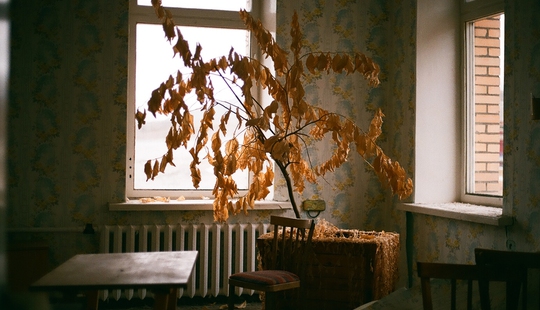 "This plant was left like everything else in 1998 and still has it leaves on. Because of the tough climate things decay very slowly here. There are no bugs and low temperatures. We recorded the sound of these leaves.
"This plant was left like everything else in 1998 and still has it leaves on. Because of the tough climate things decay very slowly here. There are no bugs and low temperatures. We recorded the sound of these leaves.
A slightly crude observation is that Efterklang’s albums have become more pop-based as time has progressed and at present it’s a nigh-on unrecognisable band from even five or so years back. It’s perhaps the first record where their common influences have popped their heads above the often thick musical forestry.
On those influences, Stolberg says that “from the very, very early start it’s always been Einsturzende Neubauten, it’s been Talk Talk, Spirit of Eden, Laughing Stock, like lots of other bands. Maybe it’s the first album where it’s easier to tell we are into this kind of stuff and have been for many, many years.” “I actually feel we’ve got it now. This is how we were hoping a lot of the older albums would sound as well…how the drums sound, all that stuff. That’s one thing I really like,” he adds.
Where they can go from here is up in the air and trying to second guess what comes next would be a fool’s game, but Stolberg says that any Efterklang album is underpinned by the desire to make songs. Yet “experimentation” is not a dirty word and can be done under the band of any and every genre, or even none.
“I think we’re also going to try and do some very experimental stuff in different projects but probably not put it on an album, maybe put it on an EP,” he says. As for what Piramida and Efterklang at this very moment in time represents, it’s clear the trio are in as good a place as ever.
“Being able to go to the arctic to start the process of making an album is incredible. Looking back at it…I don’t know. It makes me smile! It’s fortunate that we can do this. I think we feel very inspired currently and there are so many things we would like to try and do and ideas we have.”
Looking too far ahead as a listener, and maybe even for the band, might not give Piramida the requisite time and attention it deserves. Though attention is undoubtedly what it deserves, time is not what it needs, undoubtedly being Efterklang’s most immediate work to date. Again, the feeling that a peak has been reached emerges and this may end up being the case. This time, though, you might want to think twice and then perhaps again before trying to guess what their next move will be.
Main photo by Andreas Koefoed
Piramida is out now. Read the 9/10 DiS review here

